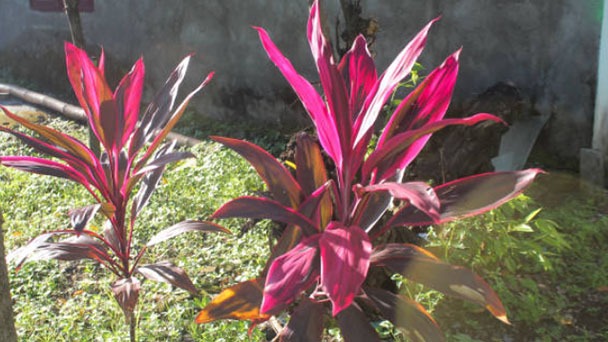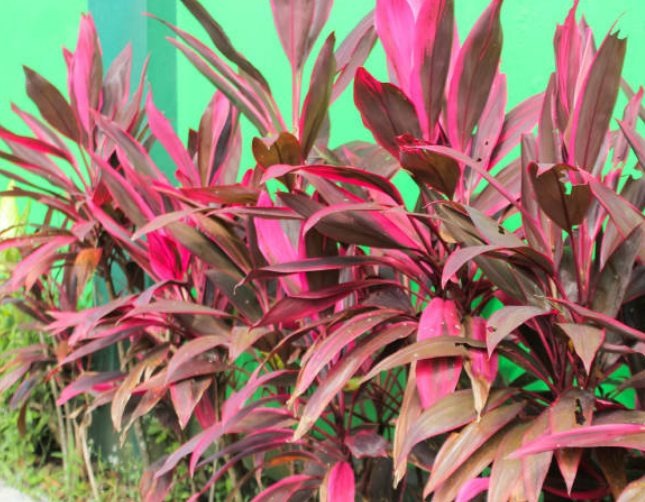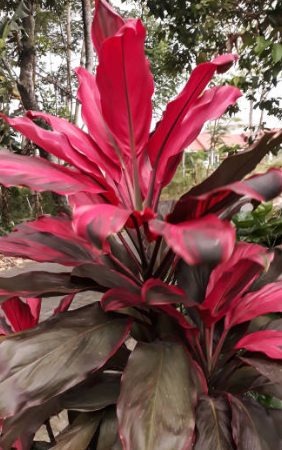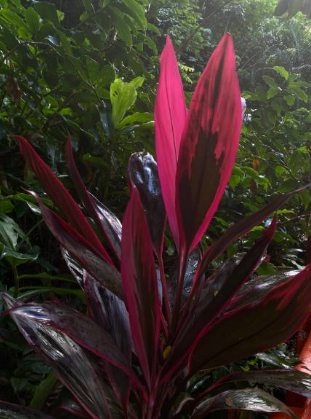Hawaiian Ti Plant (Good Luck Plant) Grow & Care
Written by Ivy
Dec 30 2022

Ti plants, also known as good luck plants, grow well indoors or outdoors in tropical climates. They also thrive with very little care. Let's talk about how to grow a ti plant at home and how it works.
Hawaiian Ti Plants Overview
There are many different colors available for ti plants (Cordyline minalis), including green, red, chocolate, pink, orange, variegated, and mixtures of all of these. They form a multi-tiered rosette and rarely bloom. They grow well indoors on their own or can be combined with other houseplants that have similar requirements to create a stunning arrangement.
| Common Name(s) | Hawaiian ti plant, ti plant |
| Scientific Name | Cordyline fruticosa |
| Family | Asparagaceae |
| Height | Up to 10 feet |
| Light | Full-partial sun |
| Water | Consistently moist soil |
| Soil | Rich, well-drained |
| Fertilizer | Balanced, average |
| Pests | Fungus gnats, root rot, leaf spot, fusarium wilt |
Hawaiian Ti Plant Care

You might use this plant in your landscaping if you're fortunate enough to already reside in a tropical area. For the rest of us, it's best to keep this plant inside where the environment can be more easily controlled. These pointers will help you maintain a Hawaiian ti plant's vibrant appearance and good health.
Light
Find a location where your Hawaiian ti plant will receive at least four to six hours of bright light if it is planted outside. Instead of direct sunlight, give it some dappled light. Indoor plants won't require as much sun, so position them three to five feet away so they can benefit from the indirect light from a window.
To avoid drying out, make sure it is far from any vents or drafty areas. The ideal temperature range for your Hawaiian ti plant is between 65 and 95 degrees Fahrenheit, which is why they make such good house plants.
Temperature
Ti plants prefer warm temperatures between 65° and 85°F (18.3° and 29.4°C). A Hawaiian ti plant should not be near vents or drafts of any kind.
Watering Your Hawaiian Good Luck Plant
Keep the soil moist (not flooded) because the Hawaiian ti plant prefers an environment with at least 75% humidity. You might also think about misting the leaves with filtered or distilled water once a day. Your schedule and personal preferences will determine how frequently and how much water you drink. So that it doesn't evaporate as quickly, think about watering in the morning or the evening. To be safe, just make sure it doesn't get too dry.
Dropping leaves indicates that you should extend your plant's happy hour periods. Try placing the container on a plate of gravel with some water in it to increase humidity if you have trouble keeping soil consistently moist. As for watering, during the growing season (spring and summer), give your plant a flush of water until it seeps out the drainage holes every other week.
Soil
In soil that drains well, your ti plant thrives. It's true that even a tropical plant that enjoys humidity like this one requires well-draining soil to thrive. Any grass or weeds that might rob your ti plant of nutrients should be completely removed from your outdoor garden, roots and all. To improve drainage, particularly if your soil is made up primarily of heavy clay, till in some peat moss and perlite.
Utilize a container with drainage holes indoors to encourage better drainage when watering. Use an outdoor-grade soil mixture inside.
Humidity
To maintain the appearance of a Hawaiian Ti plant's leaves, high humidity is required. Set your Ti plant on a wet pebble tray if your home's air is particularly dry, or keep a small humidifier nearby. Make sure the plant is on the pebbles and not submerged in water.
Fertilizing Hawaiian Ti Plants
If you notice some leaf browning, you might want to add the tiniest amount of diluted fertilizer or tropical plant food. Whatever kind you select, make sure to add it with some distance. To avoid burning, keep it far from the stems and leaves. In the spring and summer, fertilize only once a month. Fall and winter are not good times to fertilize.
Repotting Ti Plants
Whether you have a three-foot plant or a ten-foot plant depends on the size of the pot. Until your plant reaches the desired height, start with a smaller pot and gradually increase the size. Create a hole in the ground twice the size of the root ball, fill it with loose dirt, and then insert the plant. When the area around the roots has been filled, firmly compact the soil. When finished, give it a good swig of water.
Pruning Your Hawaiian Ti Plant
Pruning ti plants is a simple process. You are welcome to remove damaged and discolored leaves at any time of year to keep your plant looking good. If your plants are starting to sag, you can prune the undesirable parts during the growing season to a height of about 12 inches above the ground. Later, you might notice some branching out occurring near the cut; use this to regulate the overall size.
Ti Plant Propagation
It is possible to take cuttings and place the canes in pots made of sand mixed with vermiculite, peat moss, or perlite as desired. To expedite the process, you can also submerge the canes in one inch of water and some fertilizer. To prevent the root initiations from rotting, occasionally change the water. Plant the cane outside or in a container with potting soil, sand, and either vermiculite, peat moss, or perlite before the roots grow too long to break easily.
The berries can be planted in containers with the aforementioned soil mixtures kept moist to produce seeds. Before planting, gently squeeze the berries to encourage quicker germination. Transplant each seedling into a separate pot when it has grown a few inches.

Hawaiian Ti Plants Varieties
In the beginning, early Polynesian settlers brought the Ti plant to Hawaii. It inhabits wetlands in tropical Southeast Asia and the Pacific. There are a staggering number of uses for ti plant leaves, including thatching roofs, wrapping food, making dishes, medicine, booze, and even skirts and sandals for women.
When it comes to choosing ti plants, there are many options. Let's talk about some of the most well-known Hawaiian ti plant varieties.
- Black Mystique Ti Plant
It thrives both indoors and outdoors in partial sunlight or shade, growing 4–8 inches tall and 3-5 inches wide.
- Candy Cane Ti Plant
The unusual hot pink and green striped variety stands out sharply from the traditional ti plant varieties.
- Florida Ti Plant
Florida is a more subdued variation of "Black Mystique," with darker purple and red flecks and stripes replacing the more flaming hot pink ones.
- Hawaiian Boy Ti Plant
A striking red and purple variety that stands out in any yard or home. It is vibrant and striking.
- Maria Ti Plant
leaves with stripes and flecks of intensely bright pink that are deep purple and green. Nice contrast.
- Morning Sunshine Ti Plant
One of the most unusual varieties due to its extreme lightness. White, yellow, and pink stripes can be seen on the leaves of green plants.
- Red Sister Ti Plant
a vibrant, almost fluorescent-looking reddish-pink to purple foliage.
Troubleshooting Ti Plants
There may be a few issues and plant diseases because this plant is delicate to changes in temperature and moisture. What you should watch out for is listed below.
Ti Plant Growing Problems
Younger leaves will die as a result of fertilizer burn caused by an excess of plant food, but the plant will live. Make sure to diluted your fertilizer of choice and to apply it far from the stems and leaves. Instances where diseases can flourish can also be brought on by overwatering. Verify that the container you use has a sizable drainage hole.
Pests
In the base of your plant, fungus gnats may lay their eggs, providing their larvae with access to roots once they have hatched. They may cause leaf drop as they eat. Reduce your watering frequency because these pests are drawn to soil that is constantly moist if you want to get rid of them from your ti plants. To eliminate any remaining eggs or larva, spray your ti plants with diluted neem oil.
Ti Plant Diseases
Yellowing and wilting leaves on the lower parts of the plant, wilting leaves and spots on the stems, possibly some yellow spore powder, and brown roots are symptoms of fusarium wilt and root rot on these plants. Put infected plants in the trash, apply a little copper fungicide, and examine your watering practices.
On the leaves and the tips of the leaves, fungus leaf spot produces brown, oval spots with a yellow ring. Perhaps the problem is excessive watering. A small amount of copper fungicide might help protect the healthy plants from contracting it.
Slimy leaves and stems, blackened roots, and rotten cuttings are symptoms of bacterial leaf spot and stem rot. There isn't much you can do besides get rid of the infected plants and make sure the new plants you get don't bring it home with them. By taking the right precautions, the disease can be avoided.

Can You Grow Ti Plants Outside?
Ti plants, Cordyline fruticosa and Cordyline terminalis, are hardy in the United States and are native to Eastern Asia, Australia, and the Pacific Islands. hardiness zones 10-12. They can tolerate a brief chill of 30 F. (-1 C.), they thrive in areas with consistent temperatures between 65 and 95 degrees Fahrenheit. (18-35 C.).
In colder regions, they should be grown in containers that can be brought inside for the winter. Although ti plants can withstand extreme heat, they are incapable of enduring drought. They can tolerate full sun to dense shade, but a moist environment with some shade is best for their growth. A shade with light filtering is advised for the best foliage display.
Ti plants are primarily grown for their vibrant, evergreen foliage. This foliage comes in a variety of hues, including dark, glossy green, deep, glossy red, and green, white, pink, and red variegations. They are known by a variety of names, including "Firebrand," "Painter's Palette," and "Oahu Rainbow," which describe their exceptional foliage displays.
Ti plants can reach heights of up to 10 feet (3 meters).) tall and are usually 3-4 feet (1 m.) wide at maturity. They can be used as foundation, accent, and privacy hedges or screens in the landscape in addition to specimen, accent, and foundation plantings.
Conclusion
In temperate climates, this evergreen tropical flowering plant is typically grown as a houseplant. Depending on the cultivar, the foliage can be shades of pale pink, green, purple, or deep red. To maintain the colors of its foliage, it does need bright light. Never let the soil at the bottom of the pot stand in water; instead, water the plant only when the top of the soil feels dry. By putting the plant in a saucer with water and pebbles, you can increase the humidity around it. Due to its sensitivity to fluoride, this plant might benefit from being watered with distilled water.
Frequently Asked Questions
Why the Leaves of My Ti Are Getting Little Brown Spots and Burned Tips?
If you are using a city tap to water, the fluoride in it is probably the cause of the issue. Instead of using tap water, try using rainwater or bottled water.
Is Hawaiian Ti Plant Indoor Or Outdoor?
Although it can grow outside in tropical climates, it is most frequently grown as a houseplant.
Can Hawaiian Ti Plants Take Full Sun?
However, they favor direct, bright light more often.
Is Hawaiian Ti Plant a Perennial?
Yes, they are tropical perennial shrubs.
How Long Do Hawaiian Ti Plants Live?
Because they typically live for 50 years or more, include them in your will.
Are Coffee Grounds Good for TI Plants?
A: Although some sources may suggest adding coffee grounds is a good idea, their acidity may harm the roots of your plants. Instead, consider a specially formulated fertilizer.
Is Hawaiian Ti Toxic to Dogs?
A: The digestive systems of dogs, cats, and young children can be harmed by the saponin compounds found in ti plants when present in high concentrations. When you can, keep them away from the three of them.
How Frequently Should I Water My Hawaiian Ti?
A: Water them every two weeks in the spring and summer, and then less frequently in the fall and winter.
Latest Updated
- Benefits of Bugleweed - 7 Science-backed Health Benefits
- Bugleweed Dangers & Side Effects - Is It Poisonous?
- How to Plant Evergreen Trees - What You Should Know
- When to Plant Evergreens - Grow Guide for Evergreen Trees
- 12 Wonderful Evergreen Shrubs for Your Garden
- 12 Popular Evergreen Plants with Pictures for Beginners
- When And How To Prune A Lilac Bush Like a Pro
- How to Grow & Care for Lilac Vine (Hardenbergia Violacea)
- Japanese Lilac Tree (Syringa Reticulata) Care & Propagation Guide
- Shumard Oak Pros and Cons - What to Know
Popular Articles
- Winter maintenance of Antirrhinum Majus
- How to Grow Terminalia Mantaly Tree
- How to Grow and Care for Crossostephium Chinense
- How to grow Antirrhinum Majus in spring
- Peristeria Elata (Dove Orchid) Profile: Info & Care Guide
- Underwatered Snake Plant (Sansevieria Trifasciata) - Signs And How To Fix
- How to Care for Brazilian Jasmine Plant (Mandevilla Sanderi)
- How to Grow & Care for Graptopetalum Purple Delight in Summer
- Rosa Chinensis (China Rose): Plant Growing & Care Tips
- How to Care for Baby Sun Rose (Aptenia Cordifolia)